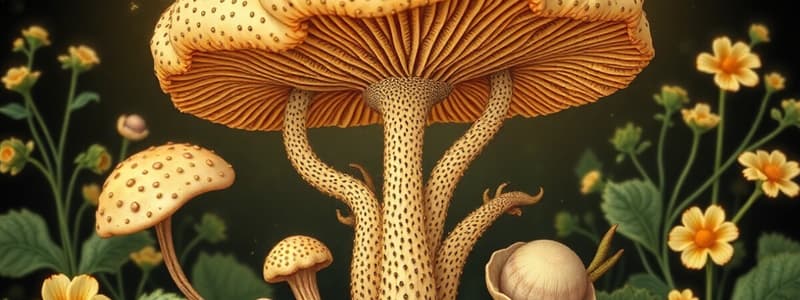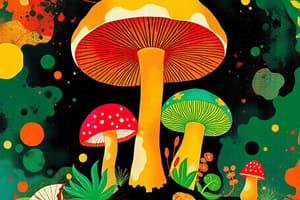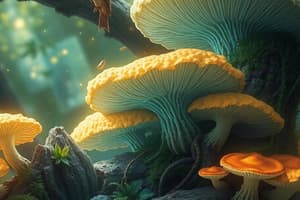Podcast
Questions and Answers
What defines the reproduction of gymnosperms?
What defines the reproduction of gymnosperms?
- They have seeds enclosed within a protective ovary.
- They produce both male and female spores in separate structures.
- Their seeds are exposed and not enclosed in an ovary. (correct)
- They rely solely on wind for pollination.
Which of the following statements about fungi is true?
Which of the following statements about fungi is true?
- Fungi do not form symbiotic relationships with plants.
- Fungi are considered autotrophs because they can produce their own food.
- Fungi reproduce exclusively through sexual reproduction.
- Fungi play significant roles in the decomposition of organic matter. (correct)
What is the main advantage of having seeds in plants?
What is the main advantage of having seeds in plants?
- Seeds provide protection and facilitate dispersal. (correct)
- Seeds allow for immediate germination without environmental requirements.
- Seeds primarily increase the size of the embryo.
- Seeds are exclusively produced under water.
What distinguishes the lifecycle of angiosperms from that of gymnosperms?
What distinguishes the lifecycle of angiosperms from that of gymnosperms?
Which of the following best describes the life cycle of fungi?
Which of the following best describes the life cycle of fungi?
What group of angiosperms includes approximately 170,000 species?
What group of angiosperms includes approximately 170,000 species?
Which characteristic is true for the reproductive phase of Basidiomycetes?
Which characteristic is true for the reproductive phase of Basidiomycetes?
What role do fungi play in the decomposition of organic matter?
What role do fungi play in the decomposition of organic matter?
Which type of symbiotic relationship is enhanced by arbuscules in fungi?
Which type of symbiotic relationship is enhanced by arbuscules in fungi?
Which of the following is a significant economic role of fungi?
Which of the following is a significant economic role of fungi?
Which of the following significantly represents plant diversity in monocots?
Which of the following significantly represents plant diversity in monocots?
What is the primary function of hyphae in fungi?
What is the primary function of hyphae in fungi?
Which group of fungi forms arbuscular mycorrhizae and is significant for plant relationships?
Which group of fungi forms arbuscular mycorrhizae and is significant for plant relationships?
Which statement correctly describes the reproductive capabilities of Metazoa?
Which statement correctly describes the reproductive capabilities of Metazoa?
What is a defining characteristic of Eumetazoa?
What is a defining characteristic of Eumetazoa?
How do fungi primarily obtain their nutrients?
How do fungi primarily obtain their nutrients?
What are the two germ layers found in diploblasts?
What are the two germ layers found in diploblasts?
Which of the following is true regarding the lifecycle of Eumetazoa?
Which of the following is true regarding the lifecycle of Eumetazoa?
What role do choanocytes play in the Proferia (sponges)?
What role do choanocytes play in the Proferia (sponges)?
Which of the following statements about fungi is incorrect?
Which of the following statements about fungi is incorrect?
What is the process called when a zygote undergoes development in animals?
What is the process called when a zygote undergoes development in animals?
Flashcards
Basal angiosperms
Basal angiosperms
The oldest lineage of angiosperms, with about 100 species.
Arbuscular Mycorrhizae
Arbuscular Mycorrhizae
A mutualistic relationship between fungi (Glomeromycetes) and plant roots, enhancing nutrient uptake.
Ascomycetes Fungi
Ascomycetes Fungi
A large group of fungi (about 65,000 species) encompassing yeasts, cup fungi, truffles, and morels.
Basidiomycetes Fungi
Basidiomycetes Fungi
Signup and view all the flashcards
Fungi ecological roles
Fungi ecological roles
Signup and view all the flashcards
Fungi as absorptive heterotrophs
Fungi as absorptive heterotrophs
Signup and view all the flashcards
Mycelium
Mycelium
Signup and view all the flashcards
Lichen symbiotic relationship
Lichen symbiotic relationship
Signup and view all the flashcards
Fungi's Life Cycle
Fungi's Life Cycle
Signup and view all the flashcards
Seed Advantages
Seed Advantages
Signup and view all the flashcards
Gametophyte Reduction (Seed Plants)
Gametophyte Reduction (Seed Plants)
Signup and view all the flashcards
Heterosporous
Heterosporous
Signup and view all the flashcards
Gymnosperm Reproduction
Gymnosperm Reproduction
Signup and view all the flashcards
Fungi characteristics
Fungi characteristics
Signup and view all the flashcards
Animal characteristics (Metazoa)
Animal characteristics (Metazoa)
Signup and view all the flashcards
Metazoa reproduction
Metazoa reproduction
Signup and view all the flashcards
Sponges (Porifera) feeding
Sponges (Porifera) feeding
Signup and view all the flashcards
Eumetazoa tissue
Eumetazoa tissue
Signup and view all the flashcards
Diploblast germ layers
Diploblast germ layers
Signup and view all the flashcards
Cleavage (embryonic development)
Cleavage (embryonic development)
Signup and view all the flashcards
Gastrulation (embryonic development)
Gastrulation (embryonic development)
Signup and view all the flashcards
Study Notes
Generalized Life Cycle of Fungi
- Sexual reproduction: involves plasmogamy (fusion of cytoplasm) followed by karyogamy (fusion of nuclei), forming a zygote. The zygote then undergoes meiosis to produce spores, which germinate into a new mycelium.
- Asexual reproduction: the mycelium produces spores and undergoes germination, continuing the cycle. Fungi always have a haplontic life cycle.
Haploid and Diploid Stages
- Haploid and diploid are stages in a fungal life cycle.
The Evolution of Seeds
- Seeds are embryonic plants enclosed in a protective covering with stored food.
- Seeds offer protection and do not produce offspring immediately, only growing in suitable environments.
- Advantages of seeds: protection of reproduction, dispersal for colonization.
Gametophyte Reduction
- Examples of gametophyte reduction include pine trees, with their protective waxy layers, allowing for adaptation to dry environments.
- Early seed plant evolution developed sporophylls for dry environments, while gametophytes did not, and rely on their protectors instead.
Seed Plant Diversity
- All seed plants are heterosporous, meaning they produce two types of spores (megaspores and microspores)
- Most seedless plants are homosporous, producing only one spore type.
Gymnosperms
- Gymnosperms have their own unique features.
Angiosperms
- Flower Structure: Flowers are specialized structures for sexual reproduction in angiosperms. Different parts have specific functions (sepals, petals, stamens, carpels).
- Fruit Development: Fruits are the mature ovaries of flowers surrounding and protecting the seeds. They aid in seed dispersal.
- Double Fertilization: A unique feature of angiosperms. One sperm fertilizes the egg forming a zygote, the other sperm fuses with two polar nuclei to form endosperm, providing food to the growing embryo.
Fungi: Structure and Function
- Heterotrophic: Fungi absorb nutrients from their surroundings.
- Hyphae and Mycelium: Fungi are composed of thread-like hyphae organized into a mycelium.
- Spore Production: Haploid cells (spores) are produced in specialized structures for reproduction.
Ecological Roles of Fungi
- Decomposition: Fungi play a major role in decomposing organic matter, recycling nutrients.
- Symbiosis: Fungi form symbiotic relationships with plants (mycorrhizae).
Economic Importance of Fungi
- Food Production: Fungi are used in the production of various foods (e.g., cheese, bread, wine).
- Medicine: Some fungi produce antibiotics.
Harmful Effects of Fungi
- Disease: Fungi are involved in various plant and animal diseases and spoilage.
Types of Fungi
- Chytrids: Species of chytrids are found in lakes and soil.
- Zygomycetes: include species responsible for food moulds.
- Glomeromycetes: form mutualistic relationships with the majority of plants.
- Ascomycetes: a large group of fungi with significant ecological roles.
- Basidiomycetes: such as mushrooms, rusts, and puffballs.
Lichens
- Lichens are a symbiotic relationship between fungi and photosynthetic organisms (algae or cyanobacteria).
Animals: Classification and Characteristics
- Multicellular Eukaryotes: Animals are complex organisms made up of many cells.
- Heterotrophic: Animals obtain their energy by consuming other organisms.
- Reproduction: Most animals can reproduce both sexually and asexually.
Animal Phyla and Development
- Diploblasts: Ectoderm and endoderm
- Triploblasts: Ectoderm, endoderm, and mesoderm
- Radial Symmetry: Body parts radiate from a central point.
- Bilateral Symmetry: Body parts are arranged along a central axis.
Studying That Suits You
Use AI to generate personalized quizzes and flashcards to suit your learning preferences.





